Eleocharis palustris ~ Common Spike-rush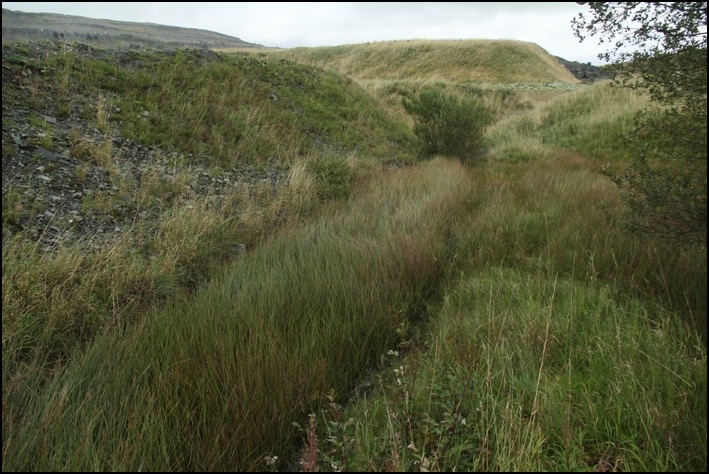
E. palustris filling a ditch, Ingleton Quarry (Yorkshire), September 2011
Eleocharis palustris subspecies waltersii
The familiar UK plant is subspecies waltersii (previously subspecies vulgaris **).
The following topics (below) are covered. Select a button, or scroll down, to go straight to a topic.
[The nominate subspecies palustris seems to be rare in UK, and may be over-recorded. It is treated below.]
Use the linked "⇑" up-arrows with each topic header to get back here, or use the 'Top' button which appears in the lower-right corner when you're further down the page.
Links to all pages are at the bottom of the page and in the sidebar (on wider screens).
** For that name-change, see Preslia 80, pp. 225–228 (2008) Eleocharis palustris subsp. waltersii, a new name for E. palustris subsp. vulgaris. Accepted in ‘Stace 4’.
➢ a robust and often tall-stemmed plant (only austriaca compares for height), but very variable
➢ stems dark to mid- or even pale green, often somewhat flattened, more flexible and less brittle than austriaca
➢ basal sheaths often flushed red at the base
➢ patch-forming (like austriaca and uniglumis; unlike the tufted multicaulis) or even sheet-forming
➢ spikelets typically cylindric or cigar-shaped (like some other larger species, but can also be shorter and ovoid, or conical, approaching austriaca)
➢ spikelets typically many-flowered – at least 20 and often many more flowers/nuts
➢ the two basal glumes are sterile (enclosing no flower/nut), similar in size and shape to each other, short; typically each encloses just half the spikelet base with no overlap (as in austriaca; contrast uniglumis and multicaulis which both have a single +/- enclosing sterile basal glume)
➢ stigma 2-forked (as in austriaca and uniglumis; contrast multicaulis and the three smaller species all of which are 3-forked)
➢ ripe nut has style-base distinctly swollen, and constricted at the attachment to the nut, with a 'neck' (as in austriaca, multicaulis and uniglumis; contrast quinqueflora and the smaller species)
➢ often emergent from shallow or deeper water, or on exposed mud, but very catholic in occurrence.
Growth & size ⇑
➢ strongly-creeping rhizome: makes patches or sheets
➢ stems often to 50 cm or more in height (matched only by austriaca), often rather dark green and shiny (but can be more apple- or yellowish-green, so more like austriaca)
➢ stems typically more than 1 mm across, circular in section, or more often somewhat flattened; flexible and much less likely to snap like the brittle austriaca

typical red-based stems (scale is 5 cm)
Spikelets ⇑
➢ cylindric, cigar-shaped, or lanceolate (like the other larger species, but can also be shorter and ovoid, and some may be strongly conical like austriaca when mature
➢ the two basal glumes are similar in size, short, and typically each encloses just half the spikelet-base with no, or very little, overlap (distinct from uniglumis). (The basal glumes are both somewhat rigid, and have distinct bract-like green midribs, rather unlike the more ‘chaffy’ glumes making up the fertile part of the spikelet above.)
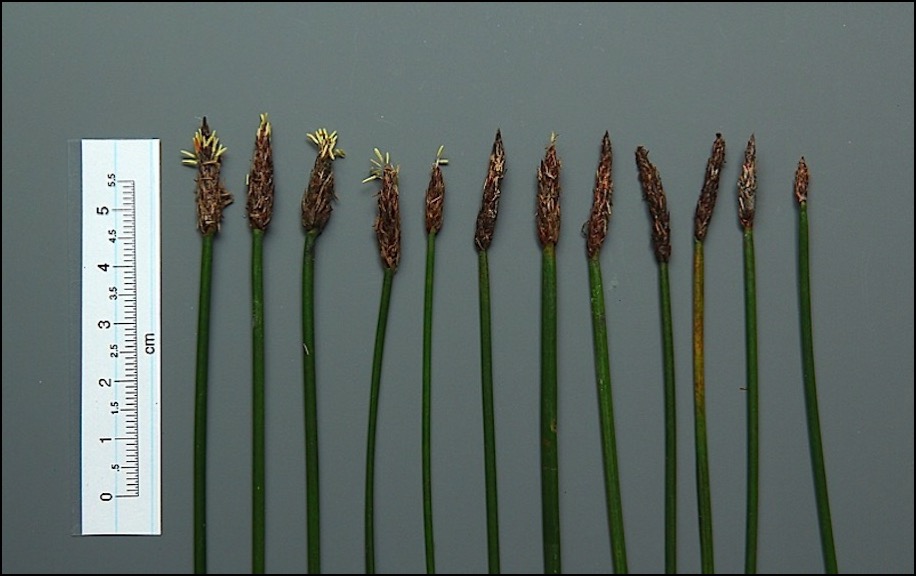
spikelets at an early stage of the season with some still in flower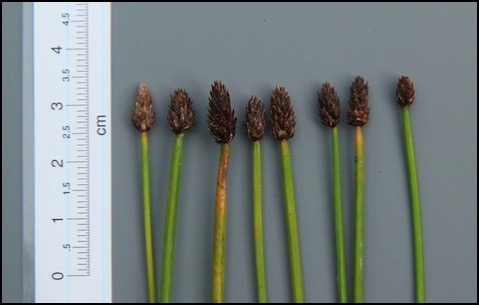
a form with short and +/- conical heads, late season and ripe (austriaca-like)
Flowers ⇑
➢ stigma 2-forked
➢ perianth bristles usually 4
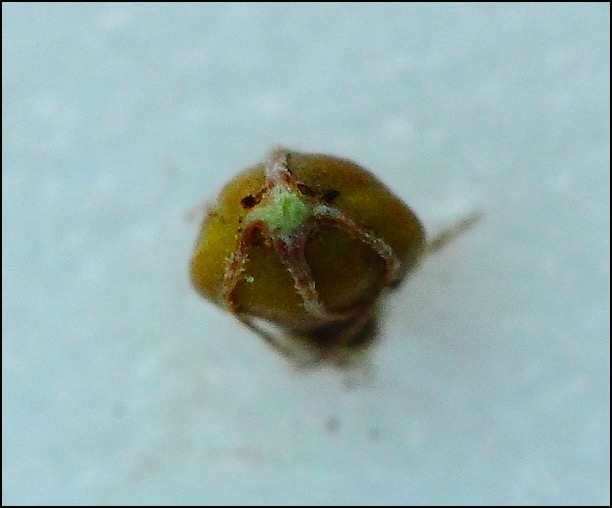
base of nut showing four perianth bristles arising from the ‘collar’
Nuts ⇑
➢ style-base (stylopodium) is strongly swollen
➢ style-base has a constriction (‘neck’) at its junction with the nut
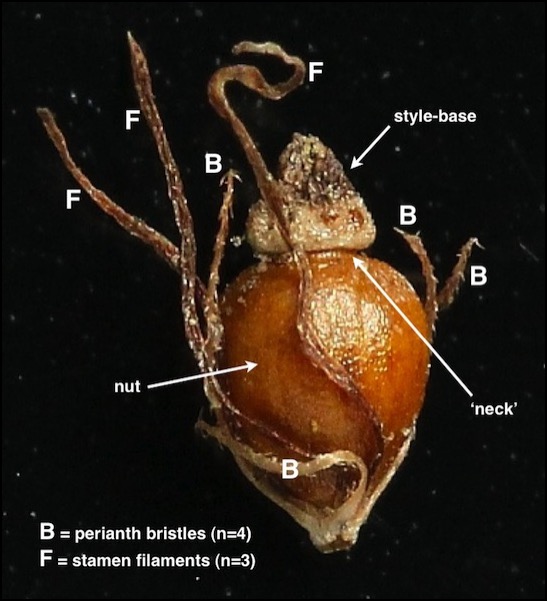
ripe nut showing swollen style-base with constricted ‘neck’,
four perianth bristles (B; note downcurved hooks)
and three stamen filaments (F)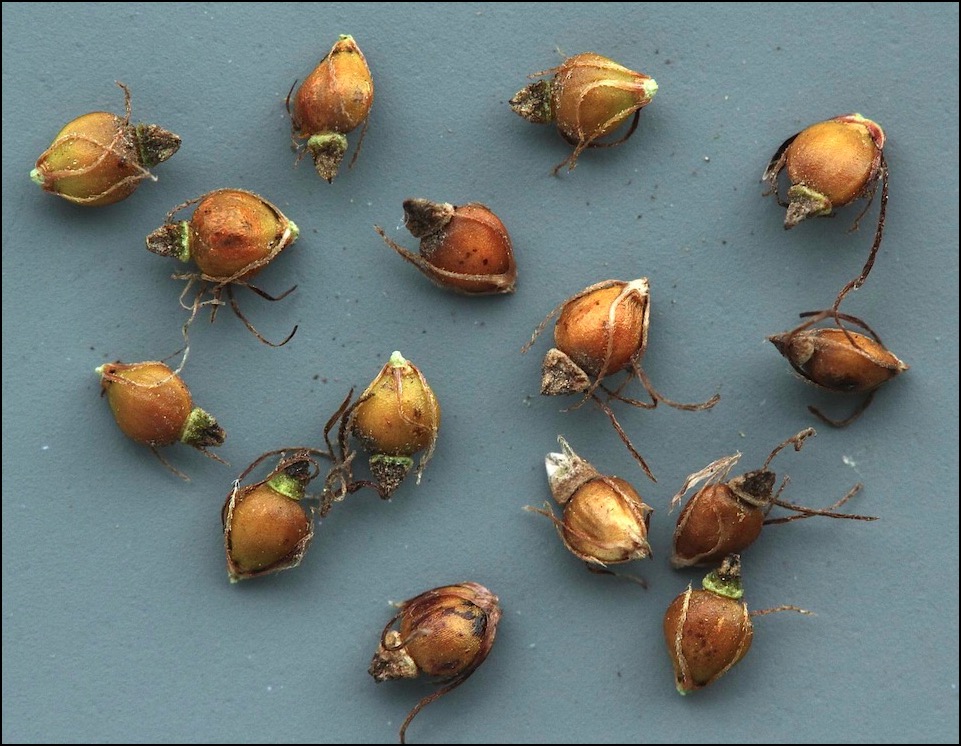
nuts, showing style-base swollen and constricted at junction with nut,
perianth bristles (paler brown), and stamen filaments (dark brown)
Stem sections ⇑
➢ see ⇒ID: palustris/austriaca for discussion. Note somewhat oval section; thick green tissue with two palisade layers.
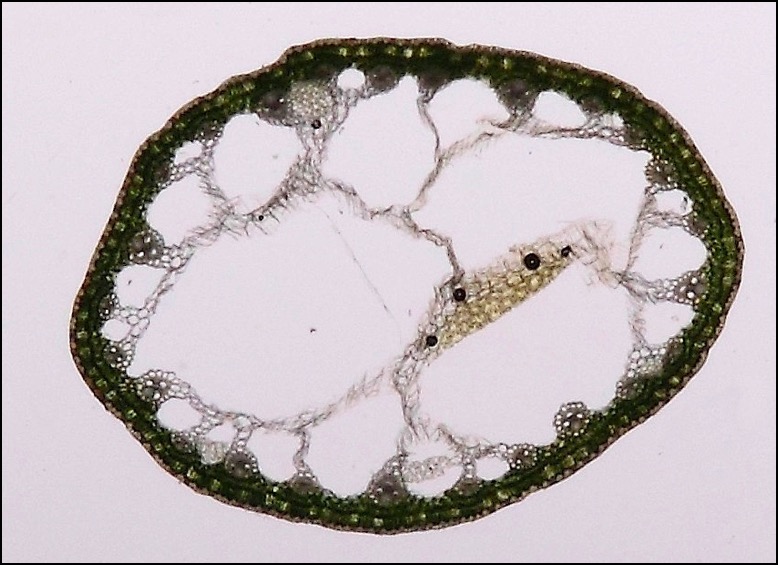
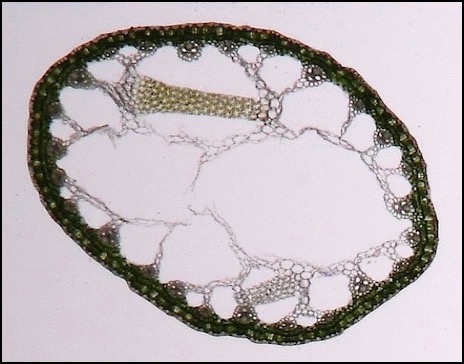

Epidermis ⇑
➢ many fibre-bundles between the ranks of open cells carrying stomata. Vegetative material can be separated from austriaca: see ⇒ID: palustris/austriaca for discussion.
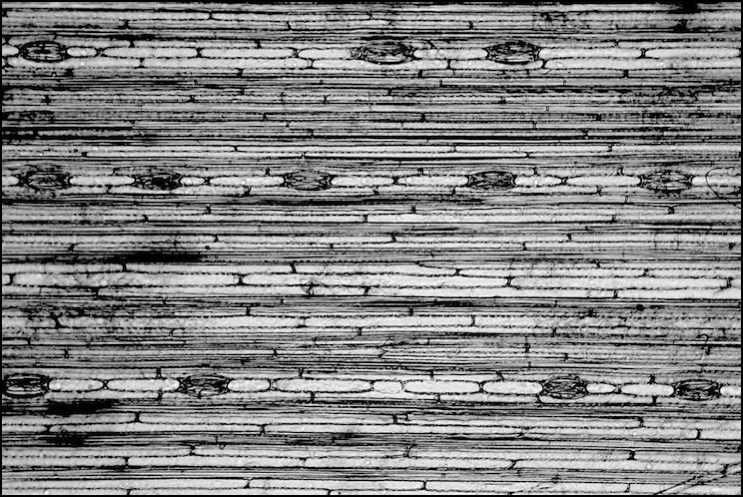
Stomata
➢ the size and form of the stomata are very useful for distinguishing vegetative palustris subsp. vulgaris from austriaca. Go to ⇒ID: palustris/austriaca for full discussion.
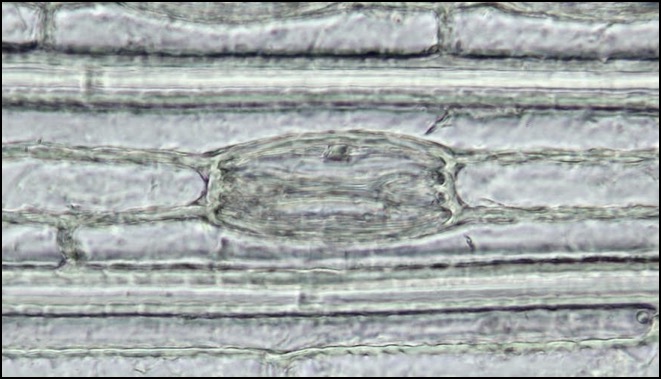
Habitat ⇑
➢ marshes and edges of waterbodies of all sorts; even in swiftly flowing water
Frequency & range
➢ very frequent throughout. See ⇒distribution map.
Eleocharis palustris subspecies palustris ⇑
The species exists at two ploidy levels (i.e. cells carry different numbers of chromosomes), and these are regarded as representing subspecies, possibly separable on various characters (see the summary in the BSBI Handbook No. 1 Ed. 3 Sedges of the British Isles (Jermy et al.)).
The ‘typical’ subspecies, i.e. E. palustris subspecies palustris, is apparently rare and mainly southern in UK, whilst E. palustris subspecies waltersii (ssp.vulgaris) is the common form here (see ⇒distribution maps).
According to Stace (New Flora of the British Isles Ed. 4, CUP, 2019) subspecies waltersii (ssp. vulgaris) is “probably derived from crosses between subspecies palustris and E. uniglumis”.
The most useful character seems likely to be the mean length of the stomata; Strandhede & Dahlgren (1968) give the following ranges:
- subspecies waltersii should mostly lie in the range 54-70 μm
- subspecies palustris should be mostly in the range 39-49 μm
I am very grateful to Dr Ekkehard Foerster for his comments (pers. email 2 April 2018): ‘I agree with the figures of Strandhede & Dahlgren [as above], but measurements should be done around the stem not along it, as rows along the stem may alternate with longer or shorter stomata. The size of fruits is advisable too [added below].’
Strandhede (1966) shows precisely what to measure:
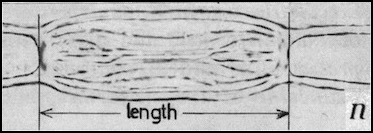
Nut lengths are for the nut only, and do not include the length of the style-base (from Strandhede & Dahlgren, 1968; Strandhede, 1966):
- subspecies waltersii are (1.3–) 1.4–1.8 (–1.9) mm long
- subspecies palustris are (1.1–) 1.2–1.5 (–1.6) mm long
Equivalent figures from BSBI Handbook No. 1 Ed. 3 Sedges…:
- subspecies waltersii are (1.3–)1.5–2.0 mm long
- subspecies palustris are (1.2–)1.4–1.5 mm long
(See ⇒ID:palustris/austriaca for methods of making the necessary epidermal peels!)
I have not as yet been able to gather any useful information on the typical subspecies in UK (besides what is available in the literature), and would welcome news, views, specimens, etc.! Please keep a lookout for it!
Dr Thomas Gregor tells me (pers. email) that in Central Europe subspecies palustris may be readily separated from subspecies waltersii by being a smaller and compact plant and growing in 'meadows'. I have not been able to discover if this habitat preference is also shown in UK – we have precious few 'meadows' left in which to look – but it should be worth keeping an eye open for 'meadow palustris' in the south of England. Dr Foerster also adds that ‘I think ssp palustris is in Germany endangered, as wet meadows disappear’.
Dr Foerster comments (pers. email, 2 April 2018) that in addition, ‘the surface of the stem is in ssp. waltersii always green and glossy while in ssp. palustris it is often dull and more or less greyish, and sometimes slightly ribbed (but there are variants with glossy surface)’.
Please send material. I am looking forward to 'opening a new page' on this website for it!
As always, Strandhede (1966; see ⇒Sources & references) should be consulted for very much more information on this form.
Hybrid ⇑
See the ⇒page on the putative hybrid between palustris and uniglumis.
Links to the other Eleocharis spike-rush pages
Species pages
Separation of similar pairs
Other information
